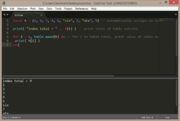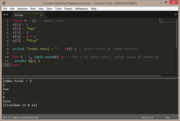Difference between revisions of "Basic lua: Tables"
From The Official Visionaire Studio: Adventure Game Engine Wiki
| Line 11: | Line 11: | ||
! method 1: automatically generated index values !! | ! method 1: automatically generated index values !! | ||
|- | |- | ||
| − | | style="max-width: | + | | style="max-width:680px;" | <syntaxhighlight lang="lua"> |
local t = {1, 2, 3, 4, 5, "six", 7, "ate", 9} -- automatically assigns an index number to each value starting from 1. | local t = {1, 2, 3, 4, 5, "six", 7, "ate", 9} -- automatically assigns an index number to each value starting from 1. | ||
print( "index total = " .. #(t) ) -- print total of table entries | print( "index total = " .. #(t) ) -- print total of table entries | ||
| − | for i = 1, | + | for i = 1, #t do -- for 1 to table total, print value of index number |
print( t[i] ) | print( t[i] ) | ||
end | end | ||
| Line 26: | Line 26: | ||
! method 2: manually created index values !! | ! method 2: manually created index values !! | ||
|- | |- | ||
| − | | style="max-width: | + | | style="max-width:680px;" | <syntaxhighlight lang="lua"> |
| − | local t = { | + | local t = { |
| − | + | ||
| − | + | [1] = 1 | |
| − | + | [2] = "two" | |
| − | + | [3] = 3 | |
| − | + | [4] = 2 * 2 | |
| + | [5] = "five" | ||
| + | |||
| + | } | ||
print( "index total = " .. #(t) ) -- print total of table entries | print( "index total = " .. #(t) ) -- print total of table entries | ||
| − | for i = 1, | + | for i = 1, #t do -- for 1 to table total, print value of index number |
print( t[i] ) | print( t[i] ) | ||
end | end | ||
</syntaxhighlight> || width="200px" | [[File:lb_tables_002.png|thumb|right|180px|click to enlarge]] | </syntaxhighlight> || width="200px" | [[File:lb_tables_002.png|thumb|right|180px|click to enlarge]] | ||
|}{{toc}} | |}{{toc}} | ||
Revision as of 18:43, 2 September 2022
Tables are one of the features of Lua script, that make the scripting language so dynamic & easy to use, as they allow us to easily create tables, insert, remove & sort data. Tables are often comprised of arrays that usually involve keywords - or an index number - & a value. Tables can be accessed using multiple different methods.
| < | Index | > |
Creating a table
| method 1: automatically generated index values | |
|---|---|
local t = {1, 2, 3, 4, 5, "six", 7, "ate", 9} -- automatically assigns an index number to each value starting from 1.
print( "index total = " .. #(t) ) -- print total of table entries
for i = 1, #t do -- for 1 to table total, print value of index number
print( t[i] )
end
|
| method 2: manually created index values | |
|---|---|
local t = {
[1] = 1
[2] = "two"
[3] = 3
[4] = 2 * 2
[5] = "five"
}
print( "index total = " .. #(t) ) -- print total of table entries
for i = 1, #t do -- for 1 to table total, print value of index number
print( t[i] )
end
|

